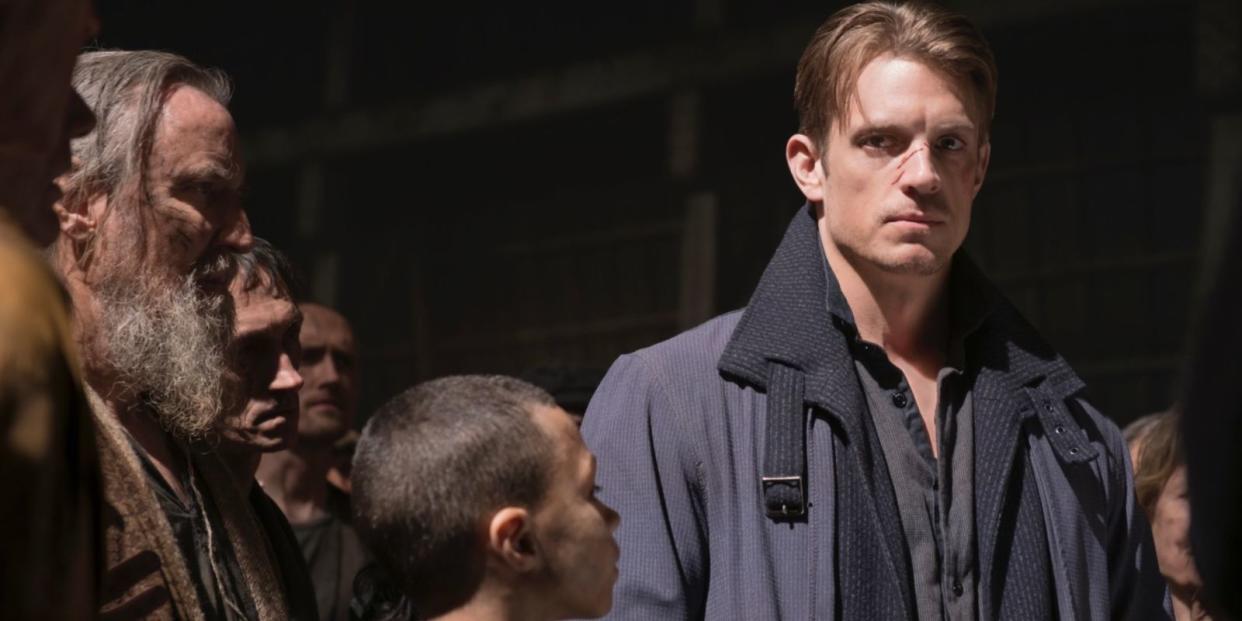Altered Carbon review: Your next Netflix addiction?

The words "noir", "dystopian" and "cyberpunk" have been thrown around in anticipation of Laeta Kalogridis' new Netflix sci-fi Altered Carbon and it's easy to see why. The thriller, based on Richard K Morgan's novel of the same name, certainly has a rich and disarming futuristic aesthetic where technology is improving lives but also bringing out the worst in the 1% who can afford to tinker with the system.
What was formerly San Francisco is now Bay City, a heavily populated metropolis that falls under the jurisdiction of the Bay City Police Department (BCPD). All citizens of the former United States of America are now citizens of the Protectorate, a new order established 250 years ago.
At that time, Takeshi Kovacs was part of a group of mercenaries known as 'envoys' that fought against the new order in the Battle of Stronghold. He was the sole survivor. Their mission failed, the Protectorate seized control and the envoys went down in history as terrorists and barbarians.
Altered Carbon opens with a striking credit sequence where a woman appears to shed her own face as a snake weaves itself around her naked body. The images are reminiscent of the skeletal figures in the title sequence of HBO's Westworld; a female form still under construction. "Your body is not who you are", says an appropriately disembodied voice. "You shed it like a snake sheds its skin".
All soon becomes clear when Takeshi Kovacs, now in the form of Joel Kinnaman rather than his previous Korean body (Will Yun Lee), is released from a human-sized sealed bag. He has an umbilical cord of sorts pulled from his mouth and is left coughing and spluttering, naked on a laboratory floor.
It's 250 since the Battle of Stronghold and Kovacs has been reborn, or, rather, 're-sleeved': when a Protectorate citizen is one year old, they have what is known as a 'cortical stack' implanted into the base of their neck. Human mind codes are stored in the stack as 'DHF' or 'Digital Human Freight'. Bodies are mere 'sleeves', and sleeves are replaceable.
You can only achieve what is known as 'real death' if your stack is destroyed, otherwise your stack sits in holding and waits for a new sleeve from the government's available inventory of prisoner bodies. All in all, it's not that easy to die.

Laurens Bancroft (James Purefoy) is the man who funded Kovacs' revival. Bancroft was murdered and when he was 'spun up' into a new sleeve, he was unable to recall the events and visualise the culprit. Kovacs has been purchased to solve the case in exchange for his freedom and 50 million UN credits… but he seems to have other reasons to stay out of storage too.
Altered Carbon's vast, sprawling metropolis is truly a marvel to behold. While the street-level shots of Bay City evidently pay homage to the dystopian and Asia-inspired Blade Runner, complete with perpetual rain and transparent umbrellas, the internal architecture has a unique and distinctive look. It's a digital-meets-organic aesthetic; fitting given that the city's citizens are a fusion of the two.
Altered Carbon looks magnificent. But its themes are also fascinating, using a world that deals in sleeves to examine class divides and religious approaches to the notion of the body and the soul. With such a smart and intricately created futuristic dystopia from the original novel, it would be tough to do a bad job with this show.

It does, however, have its flaws. Considering that the new futuristic world comes with a lot of code names for its fictional technology, the characters have a habit of mumbling their way through long expository dialogue. While Ortega is most guilty of this, Kovacs does his fair share of muttering while delivering crucial new information. You're best off putting the subtitles on when things start to get confusing.
The narrative also takes its sweet time to get where it's going. The show's first episode sets up the premise at a considerable pace (so much so you may want to give it a re-watch to fully understand the stacks and sleeves system), but once the basics are established it can feel as though the narrative rests on its laurels a bit.
Sure, there's plenty to look at and lots of blood spilled, but the central story stalls and it can feel like a great film stretched too far over 10 hours.
Joel Kinnaman carries the show brilliantly (frequently while topless and in various states of excruciating pain). Kovacs' steely "I don't love anyone" approach can border on one-note at times, much like Martha Higareda's Ortega being relentlessly no-nonsense, but it goes to demonstrate the power of a strong cast that this doesn't get in the way of the overall believability of this new and tech-driven world.
With strong performances, gorgeous visuals and a genius core premise, you can overlook its faults and enjoy plugging into the world of Altered Carbon.
Altered Carbon launches all 10 episodes exclusively on Netflix on Friday, February 2.
Want up-to-the-minute entertainment and tech news? Just hit 'Like' on our Digital Spy Facebook page and 'Follow' on our @digitalspy Twitter account and you're all set.
You Might Also Like

 Yahoo News
Yahoo News 
